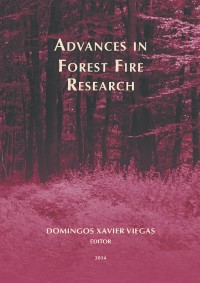Please use this identifier to cite or link to this item:
https://hdl.handle.net/10316.2/34351| Title: | Potential impact of climate change on live fuel moisture dynamic at local scale | Authors: | Pellizzaro, Grazia Dubrovsky, Martin Bortolu, Sara Arca, Bachisio Ventura, Andrea Duce, Pierpaolo |
Keywords: | Forest fires;Mediterranean shrub;Fuel status;Fire danger season | Issue Date: | 2014 | Publisher: | Imprensa da Universidade de Coimbra | Journal: | http://hdl.handle.net/10316.2/34013 | Abstract: | According to projections on future climate, an increase in risk of summer droughts is likely to take place in Southern Europe. More prolonged drought seasons induced by climatic changes are likely to influence general flammability characteristics of fuel, affecting species composition and live and dead fuel ratio. Moreover, variations in precipitation and mean temperature could directly affect live fuel water content, and length of critical periods of high ignition danger for Mediterranean ecosystems. The flammability of vegetation is influenced by several factors that include structural properties, chemical properties and moisture content. Several studies have also highlighted the importance of vegetation moisture content in relation to ignition and rate of spread in Mediterranean shrubs. The main aim of this work was to propose a method for evaluating possible impacts of future climate change on live moisture dynamic and length of fire danger period at local scale by using weather generator techniques. In particular, in this work i) threshold values for drought indices that indicate the end of fire season due to live fuel status in Mediterranean shrubland were identified, and ii) potential impacts at local scale of future climate changes on the duration of fire danger period were simulated. The study was carried out in Sardinia (Italy). Moisture content of live fuel (LFMC) was determined periodically for 8 years on three shrub species. Seasonal patterns of LFMC were compared with the Drought Code (DC) of the Canadian Forest Fire Weather Index and the Keetch–Byram Drought Index. A threshold value of DC useful to determine the end of the potential fire season due to fuel status was identified. A weather generator linked to climate change scenarios derived from 17 available General Circulation Models (GCMs) was used to produce synthetic weather series, representing future climates, and then the expected changes of the fire season length was determined. Results confirmed that the projected climate scenarios over the Mediterranean area will determine an overall increase of the fire season length. | URI: | https://hdl.handle.net/10316.2/34351 | ISBN: | 978-989-26-0884-6 (PDF) | DOI: | 10.14195/978-989-26-0884-6_134 | Rights: | open access |
| Appears in Collections: | Advances in forest fire research |
Files in This Item:
| File | Description | Size | Format | |
|---|---|---|---|---|
| 978-989-26-0884-6_134.pdf | 1.61 MB | Adobe PDF |  |
Items in DSpace are protected by copyright, with all rights reserved, unless otherwise indicated.
